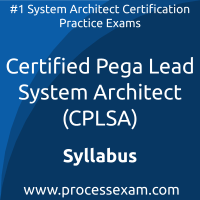 To achieve the professional designation of Certified Pega Lead System Architect from the Pega, candidates must clear the CPLSA Exam with the minimum cut-off score. For those who wish to pass the Pega Lead System Architecture certification exam with good percentage, please take a look at the following reference document detailing what should be included in Pega PEGACPLSA24V1 Exam preparation.
To achieve the professional designation of Certified Pega Lead System Architect from the Pega, candidates must clear the CPLSA Exam with the minimum cut-off score. For those who wish to pass the Pega Lead System Architecture certification exam with good percentage, please take a look at the following reference document detailing what should be included in Pega PEGACPLSA24V1 Exam preparation.
The Pega CPLSA Exam Summary, Sample Question Bank and Practice Exam provide the basis for the real Certified Pega Lead System Architect (CPLSA) exam. We have designed these resources to help you get ready to take Certified Pega Lead System Architect (CPLSA) exam. If you have made the decision to become a certified professional, we suggest you take authorized training and prepare with our online premium Pega Lead System Architecture Practice Exam to achieve the best result.
Pega CPLSA Exam Summary:
| Exam Name | Certified Pega Lead System Architect |
| Exam Code | CPLSA |
| Exam Fee | USD $190 |
| Exam Duration | 120 Minutes |
| Number of Questions | 60 |
| Passing Score | 65% |
| Format | Multiple Choice Questions |
| Schedule Exam | Pearson VUE |
| Sample Questions | Pega PEGACPLSA24V1 Exam Sample Questions and Answers |
| Practice Exam | Certified Pega Lead System Architect (CPLSA) Practice Test |
Pega Lead System Architecture Syllabus Topics:
| Topic | Details | Weights |
|---|---|---|
| Pega Platform Design |
- Recognize the significance of Center-out business architecture and its importance in designing Pega enterprise applications.
- Leverage Pega applications; Identify when to incorporate other Pega products. - Know about Multitenancy architecture and High availability features. - Awareness of features like Pega Process Fabric, and Process Mining. - Knowledge on Hazelcast, Containerization, and Cloud deployment architecture. - Aware of Agile Workbench and Agile Studio functionalities. - Apply production deployment best practices. - Define a release pipeline. - Modular deployment strategies. - Deployment responsibilities. |
15% |
| Pega Platform Design Extended |
- Adoption of App Studio in application development.
- Understand Prediction Studio, and Admin Studio. - Reuse assets and relevant records, configuration sets. - UX design fundamentals, DX API, Constellation, Landing pages. - User experience and accessibility - Implementation of Pega GenAI Suite. - Pega GenAI Blueprint and Workflow design. |
10% |
| Application Design |
- Analysis of Microjourney in designing Pega applications.
- Know about design approach in application structure - Pega Express best practices and design patterns. - Design an effective case structure, Design case hierarchy. - Object-oriented Pega development and SOLID principles. - Evaluate when to use circumstance, class, ruleset, and application specialization. - Understand how specialization layers can be designed. - Test Automation and Scenario tests. - Establishing quality standards and metrics. - Customization of Rule check-in approval. |
15% |
| Application Design Extended |
- Best practices in work assignment
- Case participants and routing - Get Next work feature and customization - Understanding alternative ways to find the work - Handling flow changes for cases in-flight - Resolving flow issues by using problem flows - Handling processing using advanced background processing techniques - Designing asynchronous integration - Utilize Job schedules and Queue Processors - Know about Stream services and usage - Data flows and Data sets capability in Pega Infinity - Logs and Alerts - PDC and Log analysis tools - Resilience |
15% |
| Data Model Design |
- Data relationship fundamentals
- Greenfield data modelling and extend existing data model - Usage of Pega data pages and Data virtualization layer - Design a case data model to support reuse and integrity - Maintain data integrity and best practices - Dynamic class reference and polymorphism in data modeling - Extend an industry foundation model - Know the benefits of using an industry foundation data model - Aggregated data - Basics of Common Data Model and Class structure |
10% |
| Reporting Design |
- Design appropriate reporting strategy based on business need
- Design reports for performance - Reporting and data warehousing - Search and Reporting service - Identify and solve performance problems in reports - Produce queries based on generated or reformatted data - Database tunning and Reports databases - Inclusive and exclusive queries - Produce queries that include SQL Functions, Complex SQL - Use Associations, class joins, sub reports |
10% |
| Security Design |
- Determine the appropriate authentication model
- Session management - Determine the appropriate authorization model - Role-based access vs. Attribute-based access - Basic Access Control - Identify and configure roles and access groups for an application - Establish dependent roles hierarchy - User management and advanced authentication service - Determine the rule security mode. - Security auditing, Security event logging, Security Alerts - Identify security risks and potential vulnerabilities - Detect and mitigate possible attacks - Content Security Policies and Rule Security Analyzer - Use security best practices |
15% |
| Interface Design |
- API design approach
- API access control - API based CRUD operations - Externalization of services - Deploying and managing external services - Best practices in externalization of services |
10% |
Both Pega and veterans who’ve earned multiple certifications maintain that the best preparation for a Pega CPLSA professional certification exam is practical experience, hands-on training and practice exam. This is the most effective way to gain in-depth understanding of Pega PEGACPLSA24V1 concepts. When you understand techniques, it helps you retain Pega Lead System Architecture knowledge and recall that when needed.
